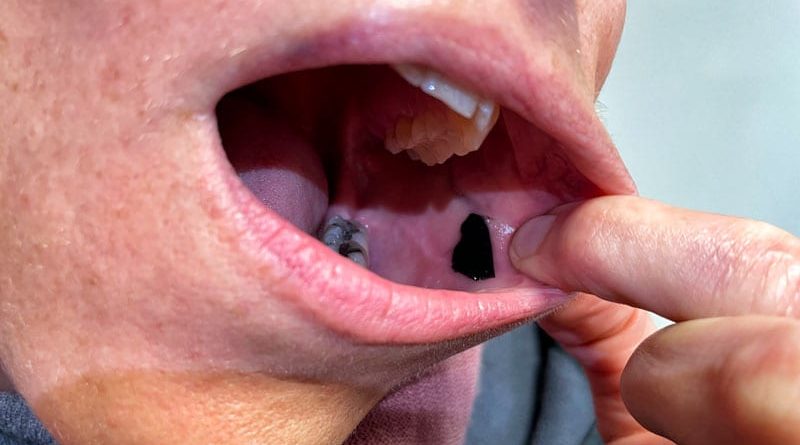Buccal Patches and Films Could Make Prescriptions Easier to Take
One of the most common ways of taking a drug is to swallow a pill. However, young children and people with health conditions ranging from Parkinson’s disease to throat cancer can have trouble getting down a tablet or capsule. Other drugs, such as insulin, need to be injected, which can be painful and even trigger phobias. To overcome these issues, researchers are developing new ways of administering drugs that are easier, more convenient, and could work faster and have fewer side effects than traditional methods.
Two of the most up-and-coming technologies, buccal films and buccal patches, deliver drugs via the inside lining of the cheek. The major difference between the two is that films dissolve away while patches stick around and have to be removed.
One benefit of the film is that it doesn’t require water, so you can take it anywhere, at any time. A benefit of a patch is that once you put it in, it’s easy to ignore. “It’s extremely thin,” said Sabine Szunerits, a chemistry professor at Université de Lille in France, about the new type of buccal patch she is developing. “You don’t even feel it.”
Buccal films for some drugs are currently available, including one that carries Suboxone, a sublingual film that contains two drugs, buprenorphine and naloxone, and is used to treat opioid dependence by reducing withdrawal symptoms.
But buccal patches aren’t on the market yet. They’re being studied for the delivery of drugs that treat conditions ranging from high blood pressure to insomnia. And researchers like Szunerits are working on innovative types of buccal patches, such as ones that only release drugs when triggered.
Some drugs, such as insulin, need to be taken multiple times throughout the day. Instead of having a buccal patch that constantly administers a drug, a trigger could be used to make the patch release the drug when needed.
In the case of Szunertis’s insulin buccal patch, a prototype of which was described in a study from February, light is the trigger. The idea is that a person could wear the patch all day, and when they need to take their insulin, they could stick a lollipop-like device in their mouth that contains a laser to release the drug. However, the device has only been tested in pigs so far and has a long way to go before it could become available to the public.
Another thing buccal films are particularly good for is treating infections of the mouth. A team of Egyptian researchers found that an oral film that delivers propolis – a resinous mixture made by bees – was effective for treating recurrent ulcers in the mouth. In a small study with 24 participants, they found that the films reduced ulcer size beginning at day two or three of treatment and cleared them up by day 10.
Interestingly, even the films that didn’t contain medication helped with pain relief, functioning more as a barrier method than as a plain placebo. The ulcers are painful to the touch, and placing the film on top of them protects them from any food or teeth that may scrape up against them. “This film acts like a barrier so it relieves pain, even if it doesn’t contain any active constituent,” said Mona Arafa, an associate professor of pharmaceutics and pharmaceutical technology at the British University in Egypt and a co-author of the study. Importantly, pain relief did last longer from the medicated film than for the placebo.
Buccal films and patches offer several advantages over swallowing a pill, said C. Michael White, a pharmacy practice professor at the University of Connecticut School of Pharmacy.
When taking a tablet or capsule, the drug has to pass through the intestines and liver before it can begin circulating throughout the body, explained White. These organs partly break down the drugs, causing them to lose some, and in some cases nearly all, of their potency. And it can take a while for the drugs to get through them, delaying how quickly they can begin to work.
These new methods of drug delivery avoid the gastrointestinal tract and the liver. The medication is either absorbed under the tongue or through the inside lining of the cheek. This allows a more rapid effect while avoiding gastrointestinal side effects such as nausea and diarrhea, which are caused by drugs passing through the stomach and intestines. They may be particularly useful for treating people with nausea and vomiting who can’t take a pill because they may throw it back up.
It also allows for a higher concentration of the drug in the body because the medication avoids initial breakdown from the liver.
When you take a pill, the concentration of the drug in your body starts high and declines as time goes on and it gets broken down. This initial spike in the concentration of the drug is the root of many side effects, White said. But a patch can release the drug into the body over a longer period of time, avoiding a spike in concentration and, potentially, some side effects.
One benefit of buccal delivery is that it allows for a rapid onset of action. The inside lining of the cheek is thin. Blood vessels are near to the surface inside the cheek, so it takes less time for the drug to get into the bloodstream, allowing it to begin having an effect sooner, White said.
That rapid onset could be particularly advantageous when timing matters. One recent clinical trial used dissolving, sublingual films to calm agitation in bipolar patients with great success in 20 minutes, but there are applications that might appeal to larger populations – like a sublingual delivery for erectile dysfunction from IntelGenx, which develops pharmaceutical films.
Think of films as Listerine breath strips, said Horst Zerbe, CEO and founder of IntelGenx. “The difference between Listerine and what we’re doing is we’re putting medication inside of the film,” he said.
The film for erectile dysfunction contains tadalafil, an FDA-approved drug for the treatment of ED. Perhaps the greatest benefit of taking tadalafil as a film rather than as a tablet is that the drug has a longer duration of action when taken as a film, Zerbe said. According to IntelGenx, it would be the first buccal film on the market for treating erectile dysfunction.
Unlike patches, buccal and sublingual films are currently available. They’re mostly used to treat pain, including chronic pain and pain from cancer, as well as migraines, Zerbe said.
Although not available for all drugs yet, these alternative methods of drug delivery promise to make taking medicine easier as the niche grows. Not only will they benefit kids and other people who have trouble swallowing, but they will also help drugs get into the body faster, with fewer side effects, and maybe even get rid of the need for insulin injections multiple times a day.
Sources
AAPS PharmSciTech: “Formulation and Evaluation of Buccal Patches for Delivery of Atenolol.”
ACS Applied Bio Materials: “Photothermal Activatable Mucoadhesive Fiber Mats for On-Demand Delivery of Insulin via Buccal and Corneal Mucosa.”
Journal of Drug Delivery Science and Technology: “Controlled buccal patches of Zaleplon using melt granulation technique: An approach to overcome early morning awakening.”
Scientific Reports: “Propolis-based niosomes as oromuco-adhesive films: A randomized clinical trial of a therapeutic drug delivery platform for the treatment of oral recurrent aphthous ulcers.”
JAMA: “Effect of Sublingual Dexmedetomidine vs Placebo on Acute Agitation Associated With Bipolar Disorder: A Randomized Clinical Trial.”
Horst Zerbe, CEO, IntelGenx.
C. Michael White, department head & distinguished professor of Pharmacy Practice, University of Connecticut School of Pharmacy.
Mona Arafa, associate professor of Pharmaceutics and Nanotechnology, Pharmaceutics and Pharmaceutical Technology Department, British University in Egypt.
Sabine Szunerits, professor, Université de Lille in France.
Source: Read Full Article



